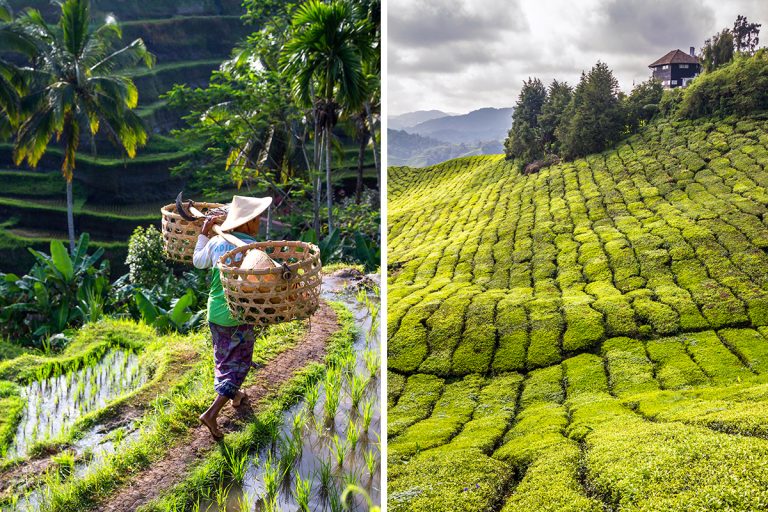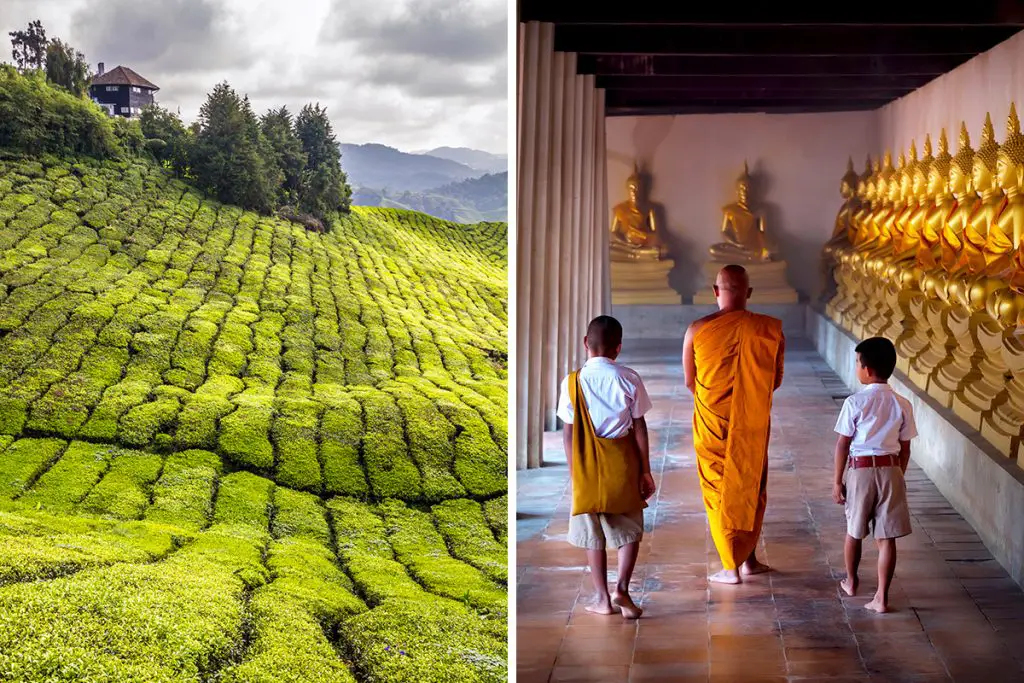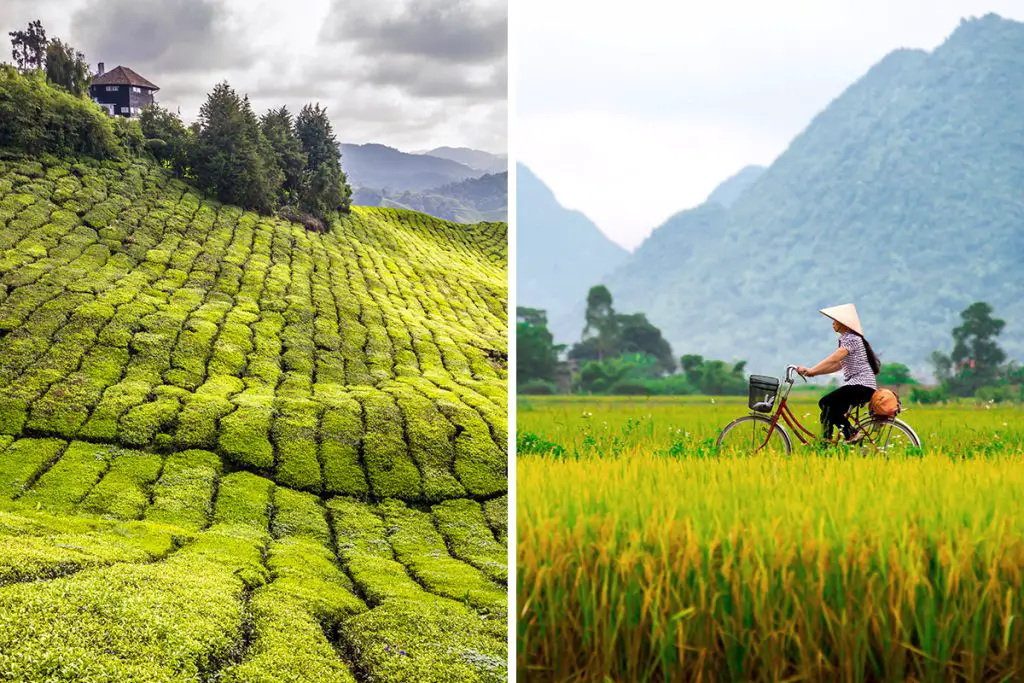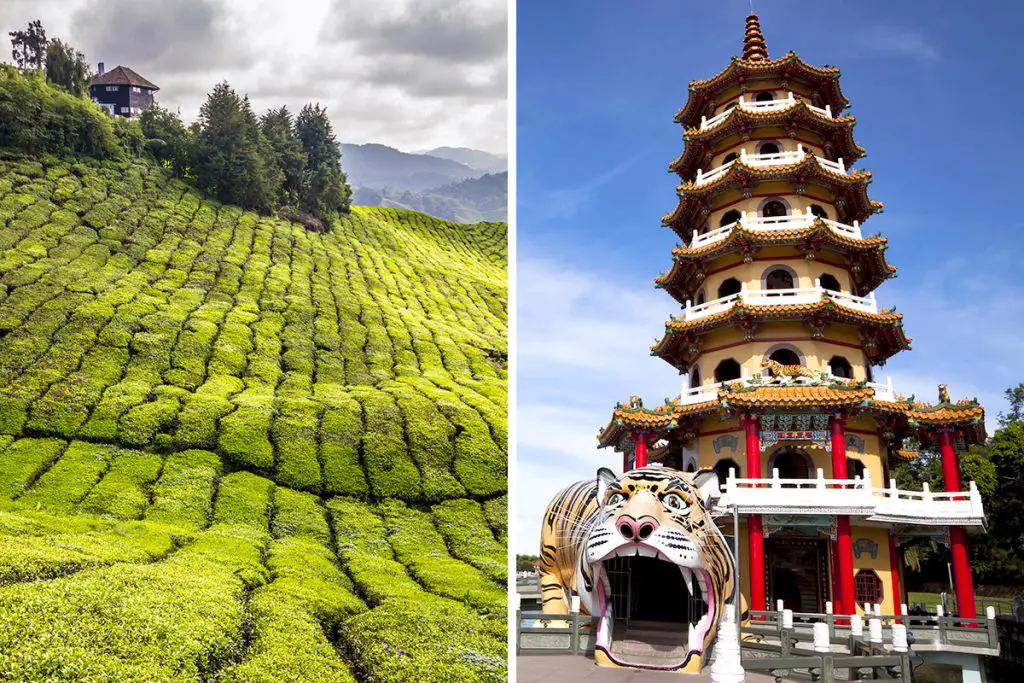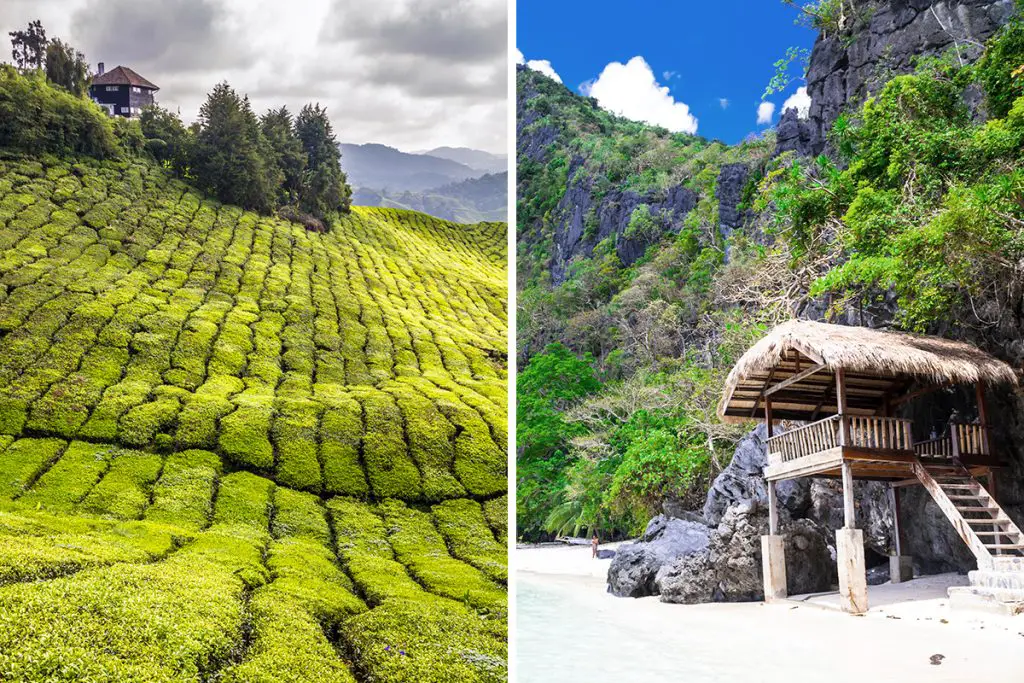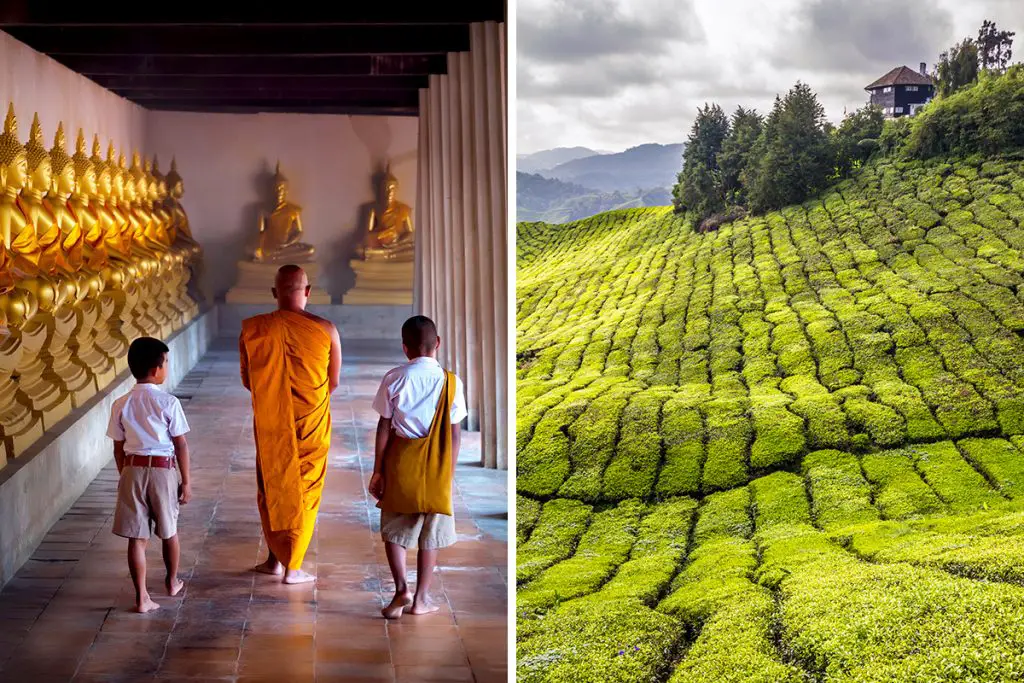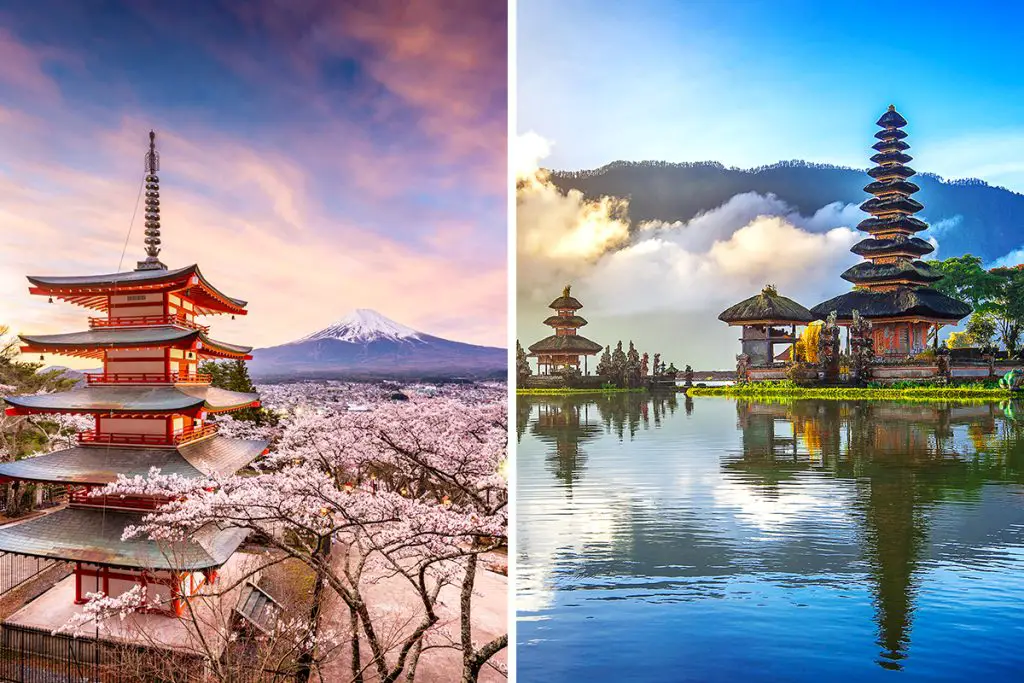Imagine the serene sounds of waves on a beach or the soft rustling of leaves in a rainforest. Picture yourself walking through narrow, bustling lanes full of history and cultural charm. Does this sound like your ideal getaway? Then either Bali or Malaysia might be your next perfect vacation spot. Discover their intriguing histories and distinctive cultures in the following sections. Let’s dive deeper into the tapestry of both destinations!
History & Culture
Your journey begins in Bali, where the island’s history is as colorful as its scenic landscape. Bali’s cultural identity finds its roots in a mix of Hindu-Buddhist tradition and indigenous Balinese customs.
Over the centuries, traders, explorers, and artists from across the globe have left their mark on the island. Yet, Balinese culture has held strong to its unique spirit, seen in its traditional dance, music, and religious festivals.
Moving on to Malaysia, the nation’s history is a grand narrative of ancient kingdoms, colonial influence, and the emergence of a modern multicultural society.
The past lives on in the harmony of its diverse population, comprising Malays, Chinese, Indians, and indigenous tribes. Each has contributed to a rich tapestry of traditions, languages, and arts, making Malaysia a melting pot of cultural experiences.
Comparing the two, Bali presents a more singular, though deeply vibrant cultural experience rooted in local tradition and spirituality. Meanwhile, Malaysia offers an expansive historical panorama with an array of multicultural influences, making it a cultural mosaic that continues to evolve.
Delving into their respective histories, both Bali and Malaysia bear the imprints of colonialism, trade, and cultural exchange. However, Bali’s history is more tightly intertwined with its unique blend of spirituality and artistic expression. Malaysia, in contrast, charts a complex historical journey of diverse ethnic groups, each bringing their distinctive traditions to the mix.
To summarize, whether you’re attracted to the singular allure of Bali’s Hindu-Buddhist-influenced- culture and arts, or drawn to the diverse cultural tapestry of Malaysia, both destinations offer a rich immersion into history and culture. Which one will be the backdrop for your next cultural exploration?
Attractions & Activities
Every great adventure requires captivating attractions and exciting activities. Bali and Malaysia offer an array of experiences that appeal to different types of travelers, each with their unique flair. From cultural landmarks to natural wonders, both destinations make each moment unforgettable.
In Bali, history and culture enthusiasts will find the ancient temples fascinating. The Uluwatu Temple, perched on a 70-meter (230-foot) high cliff, provides breathtaking views of the Indian Ocean.
Equally noteworthy, the Sacred Monkey Forest Sanctuary in Ubud is home to hundreds of monkeys and three holy temples dating back to the 14th century. Adventure seekers can explore Bali’s interior, filled with lush landscapes and active volcanoes like Mount Batur.
On the other hand, Malaysia boasts a mix of modern marvels and natural wonders. Kuala Lumpur, the capital, showcases the iconic Petronas Twin Towers, towering 452 meters (1,483 feet) high. Not too far away, the Batu Caves attract visitors with their towering limestone cliffs and ornate Hindu temples.
Nature lovers can embark on a journey to the oldest rainforest in the world, the Taman Negara National Park, home to an array of wildlife and indigenous communities.
Bali and Malaysia differ greatly in their attractions and activities. While Bali’s offerings are closely tied to its natural beauty and Hindu-Buddhist influences, Malaysia presents a more diverse selection, reflecting its multicultural backdrop and rapid modernization.
In conclusion, both Bali and Malaysia are packed with remarkable attractions and activities. Bali is perfect if you’re seeking a balance of cultural exploration and natural beauty. If you prefer a blend of modern marvels, historical sites, and rich biodiversity, Malaysia will leave you in awe. Where will your adventurous spirit guide you?
Beaches
Beaches are often the highlight of any tropical vacation. Both Bali and Malaysia are blessed with stunning coastlines, each offering a different beach experience. Time to dive into what makes the beaches of these destinations so unique!
Bali, often referred to as the ‘Island of the Gods,’ boasts some of the most stunning beaches in the world. Seminyak Beach is renowned for its golden sands stretching over 3 kilometers (1.9 miles), making it perfect for long, leisurely walks. Further east, Sanur Beach offers a more relaxed ambiance with its serene coastline and warm waters.
Malaysia’s beaches, on the other hand, offer a different allure. Langkawi, an archipelago of 99 islands, is home to some of Malaysia’s most breathtaking beaches. Pantai Cenang, the most popular beach, stretches 2 kilometers (1.2 miles) and is surrounded by numerous hotels and resorts. For a more secluded experience, the pristine white sands of Tanjung Rhu await.
When comparing the two, Bali’s beaches are generally more varied, offering both vibrant beach scenes and quiet, peaceful coves. On the other hand, Malaysia’s beaches offer an equally beautiful but more uniform experience, characterized by pristine sandy stretches and crystal-clear waters.
To sum up, whether you’re a sun-worshipper seeking the perfect tan or a beachcomber in search of solitude, both Bali and Malaysia have a lot to offer. Will you choose the varied beach experiences of Bali, or the uniform, pristine stretches of Malaysia for your next beach vacation?
Eating, Drinking & Nightlife
A trip is incomplete without diving into the local culinary scene, sipping on local beverages, and experiencing the vibrant nightlife. Bali and Malaysia, both rich in their food and drink traditions and lively after-dark activities, offer unique takes on these experiences.
In Bali, your taste buds are in for a treat. Traditional Balinese cuisine is a flavorful mix of spices, fresh vegetables, and meats. Staples like Nasi Goreng (fried rice) and Satay (skewered meat) are must-try dishes. Seafood lovers can indulge in fresh catch in the seaside town of Jimbaran.
Malaysia, on the other hand, offers a culinary journey that reflects its cultural diversity. From the rich, spicy curries of Indian cuisine to the delicate flavors of Chinese dishes, and traditional Malay fare, the Malaysian food scene is a delightful fusion. Street food in cities like Penang and Kuala Lumpur is a gastronomic adventure in itself.
When it comes to drinks, Bali is known for its locally brewed Bintang beer and Balinese rice wine, Arak. In contrast, Malaysia offers Teh Tarik (pulled tea), a traditional hot milk tea beverage, and locally made palm wine, Tuak.
Bali’s nightlife is vibrant and varied. Kuta is known for its lively bars and clubs, while Seminyak offers more upscale venues with a beachfront view. In Malaysia, Kuala Lumpur is the epicenter of nightlife, with its rooftop bars, bustling night markets, and colorful street food scenes.
In conclusion, both Bali and Malaysia promise enticing food and drink experiences coupled with exciting nightlife. Bali’s cuisine reflects its local culture and landscape, and its nightlife is diverse. Malaysia, on the other hand, offers a culinary journey across different cultures and a nightlife scene that pulsates with city life. Where will your taste buds lead you?
Shopping
Shopping can be an exciting part of travel, whether you’re hunting for unique souvenirs or high-fashion items. Bali and Malaysia each offer diverse shopping experiences to satisfy different types of shoppers.
In Bali, Ubud Art Market is a treasure trove for handcrafted jewelry, silk scarves, and traditional handmade products. Sukawati Art Market is renowned for its paintings and wooden sculptures. For high-end shopping, Seminyak offers chic boutiques with local and international designs.
Malaysia provides a different shopping experience. In Kuala Lumpur, Suria KLCC and Pavilion Kuala Lumpur are famous for luxury brand shopping. If you’re interested in traditional arts and crafts, Central Market is the place to go. For a more local experience, check out the bustling street markets such as Petaling Street and Jalan Alor.
When compared, Bali offers a shopping experience that reflects its rich artistic tradition, with a focus on local crafts and high-end fashion. Malaysia, on the other hand, caters to a wide range of shopping preferences, from luxury malls to local markets, offering an eclectic mix of modern and traditional items.
In summary, whether you’re a fan of high-end fashion or unique local crafts, both Bali and Malaysia have something to offer. Will it be the artistically rich Bali or the culturally diverse Malaysia that caters to your shopping needs on your next trip?
Accommodation
A perfect vacation begins with the perfect place to stay. Both Bali and Malaysia offer a wide range of accommodations to suit different tastes and budgets, each with its own distinct appeal.
In Bali, you have an array of options from luxury resorts to budget-friendly homestays. Ubud, a haven for nature lovers, is famous for its luxury resorts such as the Hanging Gardens of Bali, offering stunning views of the surrounding jungle. For budget travelers, affordable guesthouses and hostels are plentiful in areas like Kuta and Seminyak.
Malaysia’s accommodation landscape is equally diverse. The capital city, Kuala Lumpur, boasts luxury hotels like the Shangri-La and the Ritz Carlton. For a more local experience, consider a homestay in the countryside, like those found in the state of Kelantan. If you’re on a budget, Penang offers affordable guesthouses and hostels in the vibrant neighborhood of George Town.
Comparing the two, Bali provides a more resort-style accommodation experience, particularly in areas like Ubud and Seminyak, while also catering to budget travelers. In contrast, Malaysia offers a mix of luxury city hotels, local homestays, and affordable accommodations, particularly in its cultural hubs.
In conclusion, whether you prefer the luxury of a resort, the comfort of a city hotel, or the affordability of a guesthouse, both Bali and Malaysia offer great accommodation options. Where will you hang your hat on your next trip?
Family-Friendliness & Children’s Activities
Taking the family on a vacation can be an exciting journey. Both Bali and Malaysia offer numerous family-friendly amenities and children’s activities that make them great choices for your next family vacation.
Bali is an island of adventure that the whole family can enjoy. Waterbom Bali in Kuta is a water park with fun rides and activities for children of all ages. The Bali Safari & Marine Park, home to over 60 species, offers an educational and fun-filled day for the family.
In Malaysia, the capital city of Kuala Lumpur is home to the Petrosains Discovery Centre, an interactive science discovery center great for children. For an outdoor adventure, the Sunway Lagoon Theme Park offers various zones of fun, from a water park to a wildlife park.
When compared, Bali offers a variety of natural and adventure-filled activities that are enjoyable for both kids and adults. On the other hand, Malaysia offers a blend of educational and fun activities, with a focus on interactive experiences in urban settings.
In summary, both Bali and Malaysia offer family-friendly environments with a plethora of activities for children. Will it be the adventurous Bali or the interactive experience-rich Malaysia for your family’s next destination?
Getting There & Getting Around
Transportation is a key part of any travel experience. Both getting to your destination and moving around once you’re there are important to consider. Let’s compare the transportation options in Bali and Malaysia.
Getting to Bali usually involves flying into Ngurah Rai International Airport, located 13 kilometers (about 8 miles) south of Denpasar, Bali’s capital. Direct flights from major cities around the world make it easily accessible.
For Malaysia, most travelers arrive at Kuala Lumpur International Airport, situated approximately 45 kilometers (around 28 miles) south of Kuala Lumpur. The airport is well-connected to various international destinations.
Once in Bali, getting around is typically done by hired car, scooter, or taxi. The island is around 5,780 square kilometers (about 2,230 square miles), making most destinations relatively close. Remember to always negotiate prices before getting into a taxi.
In Malaysia, transportation options are plentiful. In cities, light rail, buses, and taxis are common. For longer distances, the country’s train system and domestic flights are convenient options.
In conclusion, both Bali and Malaysia offer straightforward options for getting there and getting around. Whether it’s the simplicity of Bali’s taxi system or the efficiency of Malaysia’s public transport, both destinations cater to the needs of the modern traveler. Which one will be your next stop?
Weather
Choosing when to visit can make a big difference in your travel experience. Both Bali and Malaysia have tropical climates, but their weather patterns differ slightly.
Bali experiences warm weather throughout the year, with an average temperature of around 30 degrees Celsius (86 degrees Fahrenheit). However, the island has two distinct seasons: the dry season from April to September and the wet season from October to March. During the dry season, you can expect sunny days perfect for beach trips.
Malaysia also experiences a tropical climate, with temperatures averaging around 28 degrees Celsius (82 degrees Fahrenheit) throughout the year. But unlike Bali, Malaysia has a more consistent rainfall pattern due to its location near the equator. Peak rainfall usually occurs between November and February, especially on the east coast of Peninsular Malaysia.
When comparing, Bali offers more predictable seasons, with clear distinctions between dry and wet periods. Malaysia, on the other hand, experiences more consistent rainfall throughout the year, but with regional differences.
In conclusion, both Bali and Malaysia enjoy warm tropical climates. However, consider the rainfall patterns and your preferred activities when deciding on the perfect timing for your visit.
Safety
Safety is a top priority when traveling. Both Bali and Malaysia are generally safe destinations, but like all places, they have their own unique considerations.
In Bali, petty crimes like bag-snatching and pickpocketing can occur in crowded areas. However, the island is generally safe, and the Balinese are known for their warm hospitality. Natural hazards, like strong currents during the rainy season, require caution. So, always heed local advice, especially when swimming or surfing.
Malaysia, particularly its larger cities like Kuala Lumpur, can see instances of petty crime. However, it’s also considered generally safe for tourists. In terms of unique concerns, Malaysia has periodic air quality issues due to haze, particularly between June and October. If you have respiratory concerns, you may want to monitor air quality during these months.
Comparatively, both Bali and Malaysia have similar safety profiles, with occasional petty crime and unique natural considerations. Both destinations require the usual safety precautions you would take when traveling.
In summary, whether it’s the serene beaches of Bali or the bustling cities of Malaysia, both places offer safe travel experiences with their own unique aspects. But, always remember to stay aware of your surroundings and heed local advice.
Cost
Budgeting for your trip is a crucial part of travel planning. Let’s compare the cost of vacationing in Bali and Malaysia.
In Bali, you can expect to pay around IDR 50,000-100,000 (around $3-$7) for a local meal, while a night in a budget guesthouse can cost IDR 150,000 ($10). For transportation, hiring a scooter for a day could cost about IDR 50,000 ($3).
In Malaysia, a typical local meal may cost around MYR 10-20 ($2-$5), and a budget hotel in cities like Kuala Lumpur or Penang might charge MYR 60-120 ($14-$29) per night. Public transportation is quite affordable, with a one-way ticket on the light rail or bus around MYR 3 ($0.7).
When comparing, Bali and Malaysia offer affordable travel experiences, with Malaysia possibly a bit cheaper for meals and accommodations, but Bali can be more economical if you’re comfortable with scooter travel.
In conclusion, whether you’re watching the sunset in Bali or exploring the streets of Kuala Lumpur, both destinations offer value for money. But, specific costs can depend on your personal preferences and travel style. Which destination fits your budget best?
Which Is Better – Bali or Malaysia?
When it comes to comparing travel destinations as diverse and vibrant as Bali and Malaysia, the choice can be challenging. Each destination offers a unique blend of history, culture, attractions, and more.
Delving into history and culture, Bali captivates you with its rich Hindu traditions and fascinating architecture, while Malaysia offers a melting pot of cultures and a mix of modernity and tradition. Thus, if you’re seeking a deeply spiritual and traditional experience, Bali may edge ahead. But, for a cosmopolitan blend of cultures, Malaysia might be more up your alley.
For attractions and activities, both countries offer a wealth of options. Bali, known for its spiritual retreats and surf spots, can provide a more laid-back and nature-oriented experience. Malaysia, with its towering skyscrapers and UNESCO World Heritage sites, presents a perfect blend of urban exploration and historical discovery.
When it comes to beaches, Bali is famed for its surf-friendly beaches and picturesque ocean views. Malaysia, however, is no slouch with its own share of pristine beaches, particularly on the eastern coast. Bali may have a slight edge for surfers, while Malaysia’s beaches might appeal more to snorkelers and divers.
For food lovers, both destinations serve a feast. But, Malaysia’s blend of Malay, Chinese, and Indian cuisines offers a slightly more diverse food scene. Bali’s food, while delicious, tends to be a bit less varied.
Regarding shopping, Bali is known for its local arts and crafts, while Malaysia offers a mix of street markets and modern shopping malls. Hence, for artisanal souvenirs, Bali might be your pick, but for a varied shopping experience, Malaysia could be a better choice.
Looking at accommodation, family-friendliness, and transportation, both destinations are quite comparable.
Bali offers a wide range of accommodations, and it’s particularly famous for its private villas. Malaysia, on the other hand, has a broad spectrum of accommodations, from budget hostels to luxury hotels. Both are family-friendly with plenty of activities for children, and they offer a range of transportation options.
In terms of weather, Bali has a clear-cut dry and wet season, making it easier for you to plan your trip. Malaysia experiences a tropical climate year-round with regional rainfall differences.
Safety-wise, both are generally safe with occasional petty crime, but also each comes with unique considerations. Bali’s safety concerns revolve more around natural hazards, while Malaysia’s are typically city-related.
When discussing costs, both Bali and Malaysia offer affordable travel experiences. However, Malaysia may be slightly cheaper in some aspects, like meals and accommodation.
In the end, the choice between Bali and Malaysia will largely depend on what you’re looking for in your travel experience. Are you looking for a spiritual and surf-friendly retreat with unique arts and crafts? Then Bali is the place for you. Or do you prefer a multicultural destination with a diverse food scene and a blend of modern and traditional attractions? Then pack your bags for Malaysia. The memories you’ll create in either will undoubtedly be priceless.

